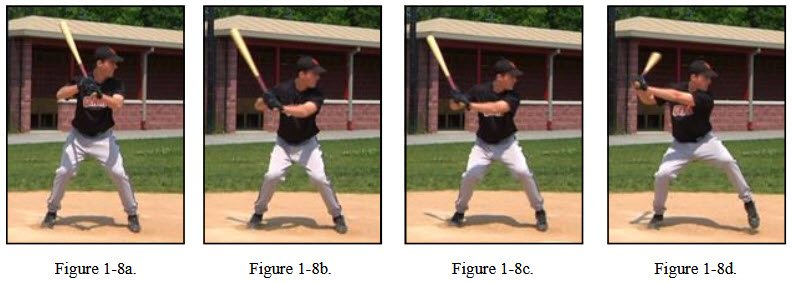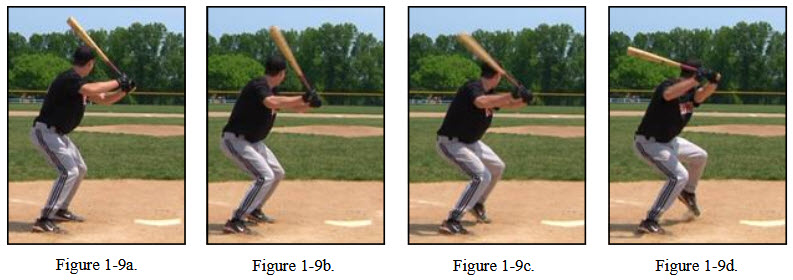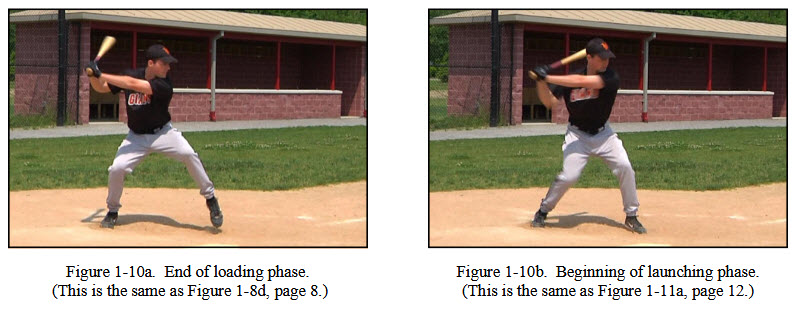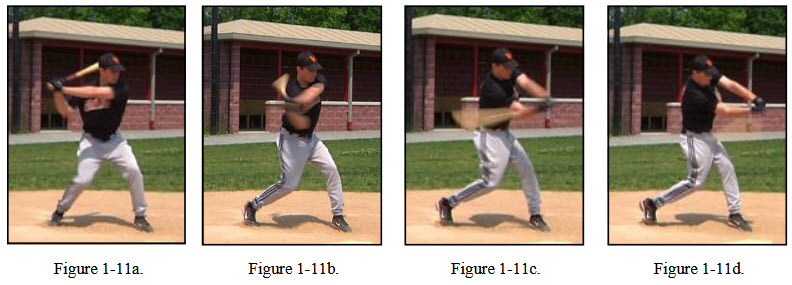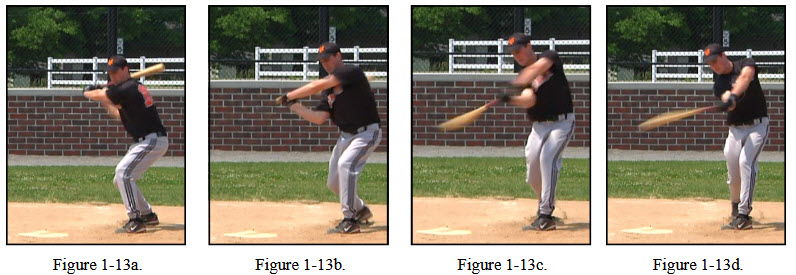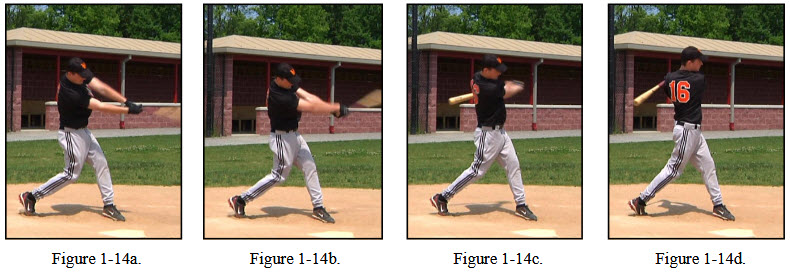Section 1 - Start Here
The Baseball Swing
(NOTE: all references to page numbers in this section refer to pages in the written portion of this program that is available for download in Section 1.)
THE BASEBALL SWING
The baseball swing consists of three main phases: 1) the loading phase, 2) the launching phase, and 3) the follow through. Each player, with their own unique style, will find themselves making adjustments to their swing depending on the type of pitch, it’s location, the pitch count, the number of outs, weather conditions and the position of the defense to name a few.
However, regardless of the batting style used and the adjustments made to it during game-time situations, the muscles involved in the baseball swing always remains the same. In this section we are going to identify all the major muscles used in each phase of a typical swing for the right-hand batter. Once you learn which muscles are involved in the swing and how to condition them for speed and power, your will become a more focused, confident and productive hitter.
However, before any of these phases are performed and the muscles are identified, getting into the proper stance is required. Therefore, let’s first identify the basic stance position along with a few variations to it for the baseball player.
The Stance.
The baseball swing begins with getting into the proper stance. Figures 1-7a, 1-7b, 1-7c and 1-7d show four different views of this. Feet and hand position vary from player to player more than anything else and in Figure 1-7a, the batter has chosen to stand with his feet a little more than shoulder width apart. A firm grip of the bat is usually preferred and the height of the hands, as well as the distance they are in front of the body, is based on preference. Figures 1-7b and 1-7d shows the hands about 10 - 12 inches in front of his body and right about shoulder level.
Some players may prefer to keep them in closer and perhaps lower or higher. Figure 1-7a shows his weight is balanced and evenly distributed between his two feet and Figure 1-7b shows the batter standing fairly tall in the box. Figure 1-7d shows that he is leaning slightly forward with the knees and hips slightly flexed and Figure 1-7c shows him on the balls of his feet.
The shoulders and hips are level in the stance position for most players as seen in Figure 1-7a, but this too, may vary slightly. The stance is truly a matter of personal preference. As long as it fits your own individual style and helps you to feel comfortable, confident and alert in the box, you’re ready to swing the bat.
The Loading Phase.
The loading phase takes us from the stance position to the launching position. There are five noticeable movements that take place during this phase and they are: 1) the backward movement of the shoulders and arms, 2) the backward rotation of the spine, 3) the beginning of the timing step, 4) the cocking of the hips and 5) the cocking of the wrists.
1) The Backward Movement of the Shoulders and Arms. The first noticeable movement that takes place during the loading phase is the backward movement of the shoulders and arms toward the catcher. This action helps to load, or stretch, different muscles in each shoulder that will be released, or contracted, later during the swing.
Let’s take a look at a sequence of movements from directly across home plate. Starting in the stance position in Figure 1-8a, follow the movement of both shoulders and arms in subsequent Figures 1-8b, 1-8c and 1-8d. Here we see both shoulders and arms moving in the same direction, back and away from the pitcher however, each shoulder uses a different set of muscles to get there.
First, the movement of the leading left arm and shoulder across the body and away from the pitcher is known as shoulder adduction. See Figure 1-8d. This is caused mainly by the action of the pectoralis major muscle (Figure 1-21, page 16) with help from the coracobrachialis (Figure 1-19, page 16), latissimus dorsi (Figure 1-22, page 16) and teres major (Figure 1-22, page 16) muscles, all on the left side of the body.
The left shoulder ends up shrugged or elevated in this position which is a function of the upper fibers of the trapezius muscle (Figure 1-21, page 16). The left scapula or shoulder blade is also protracted, or moved anterior, toward the front of the body in this position. This motion is caused by the left serratus anterior muscle (Figure 1-21, page 16). The contraction of these muscles stretches or loads the muscles on the back side of the same leading left shoulder, namely the posterior deltoid (Figure 1-22, page 16), rhomboids (Figure 1-22, page 16) and middle fibers of the trapezius muscles (Figure 1-22, page 16).
These muscles are now fully loaded, or stretched, and ready to swing forward in this position. The movement of the back (right) arm away from the pitcher and laterally raised away from the player’s body is known as shoulder abduction. See Figure 1-8d. This is caused by the supraspinatus (Figure 1-22, page 16) and middle deltoid (Figure 1-21, page 16) muscles.
The right scapula may also be slightly shrugged or elevated in this position depending on the player’s style and if so, this motion is caused by the upper fibers of the trapezius muscle (Figure 1-21, page 16). The contraction of these muscles stretches or loads the antagonist or opposing muscles on the same side of the body, namely the latissimus dorsi (Figure 1-22, page 16), teres major (Figure 1-22, page 16) and serratus anterior (Figure 1-21, page 16) muscles. These muscles are now fully loaded and ready to help swing the bat in this position.
2) The Backward Rotation of the Spine. At the same time the shoulders and arms are moving backward, muscles along the spine and abdomen are also contracting to help turn and rotate the spine (including the chest, abdomen and upper body) in the same direction.
To see this, let’s look at a similar sequence of movements from behind home plate. Starting in the stance position in Figure 1-9a where only the back shoulder is visible, follow the movement of the upper body in Figures 1-9b, 1-9c and 1-9d. Here we see the chest, abdomen and upper back also being rotated away from the pitcher to the point where now both shoulders are visible. This action of upper body and spine rotating away from the pitcher gives the appearance that the shoulders are rotating backward when in effect it is the spine that is rotating, carrying the shoulders with it.
This backward rotation of the spine is caused by the contraction of the lateral spine rotators (Figure 1-19 and 1-20, page 16). To get the body to rotate back and away from the pitcher, the lateral spine rotators on the left side of the body (‘front’ side for the right-hand batter) needs to contract or shorten.
In doing so, the trunk is turned to the side opposite to that from which these muscles act - to the right, or backward. This may be opposite of what you might think however, this has to do with the upward and oblique orientation of these muscles in the spine. The contraction of these lateral spine rotators on the left side of the body stretches and loads the exact same muscles on the opposite, or right, side of the body, which will be needed during the swing.
3) The Beginning of the Timing Step. Immediately after the shoulders and arms have started to move toward the catcher and the spine (including the chest, abdomen and upper body) has rotated as well, a short timing step with the front leg begins to occur. Look above at Figures 1-9a through 1-9d and you will notice that as the player’s body has turned inward or backward, his front foot has come off the ground signifying the beginning of this timing step. Some players may raise their foot higher than this while others may still keep their toes in contact with the ground.
Some will even turn their front knee inward to facilitate the hip-cock (discussed next), though this is not part of the batter’s technique here. But however high or low the beginning of this timing step is, the first effect of it is to force the back leg to carry the player’s weight however, since his feet are shoulder width apart at the start and not directly underneath him, the natural tendency once in this position will be to ‘fall’ forward thereby creating valuable momentum in the process. Another effect of the beginning of the timing step is that it also places an additional load on the big muscles of the back thigh and buttocks.
Looking again at Figures 1-9a through 1-9d, we see this additional load on the back leg taking place as the player’s position ends up squatted down a little more when the front foot comes off the ground. The muscles in the back leg that are further loaded during this movement are the hip extensors (Figure 1-16, page 15) and knee extensors (Figure 1-15, page 15). Besides creating momentum and loading the powerful muscles of the back leg, another purpose of the timing step is to cock the hips which is discussed next.
4) The Cocking of the Hips. Cocking of the hips refers to the backward rotation of the hips away from the pitcher and as just mentioned, it occurs in unison with the beginning of the timing step. You can see this backward turn of the hips in Figure 1-9d on the previous page. As the front leg has come off the ground both hips rotate backward, toward the catcher, and now the front side of both hips are visible.
Cocking the hips is driven by momentum created by the backward movement of the shoulders/arms and the rotation of the spine along with a shift in weight to the back leg and the inward turn of the front knee. Since the back foot remains in contact with the ground during this time, it is forced to plant firm. This creates a pivot point around the back hip for the weight of the entire body to rotate. As a result, the rear hip (thigh) is forced anatomically into medial or inward rotation.
This in turn stretches the powerful external hip rotators (Figures 1-17 and 1-18, page 16) in this same rear hip. This is the primary effect of cocking the hips and the stretching of these strong muscles stores an incredible amount of elastic energy that when timed properly, can be released to help carry out a very powerful rotational bat swing. This is why these are the muscles everyone needs to target as part of their training!
5) The Cocking of the wrists. Cocking of the wrists is an action the hands perform on the bat handle at the tail end of the loading phase (Figure 1-10a) and into the first part of the launching phase (Figure 1-10b). It’s purpose is to break inertia, or prevent the bat from coming to a dead stop, and create a rapid recoiling effect with the bat-head at the end of the player’s furthest backswing.
As the shoulders, arms and spine have moved and rotated backward as seen in Figure 1-10a, the hips, being the last to rotate back in the loading phase, are now the first to recoil and begin their explosive contraction forward in the launching phase seen in Figure 1-10b. Comparing the back hip’s position in Figure 1-10b with that of Figure 1-10a, we can see that the hips have already begun their turn toward the pitcher and this rapid change of direction by the hips occurs a split second before the head of the bat reaches its furthest backswing position.
The furthest backswing position of the bat is accomplished by a pushing of the top hand on the bat-handle so the bat-head ends up leaning back toward the hitter. This represents the cocking of the wrists and is shown in Figure 1-10b. Compare the bat-head position in this figure with that in Figure 1-10a, and you will see the bat-head is now closer to the player’s head, which is a sign that the hands and wrists are still loading, and this occurs even though the hips have already started to launch forward.
Since cocking the wrists occurs in the opposite direction as the path of the swing resulting in the bat-head pushed to it’s furthest backswing position, and since it occurs when the body is transitioning into the launching phase, it represents a point of maximum coiling power in the body. If timed at the right moment, this little extra thrust of the wrists cocking the hands on the bat-handle will create a rapid change in direction of the bat-head which increases the body’s ability to create, store and release incredible amounts of elastic energy in the arms and shoulders resulting in a more powerfully executed bat swing.
The Launching Phase.
Once all of the muscles in the body have been properly loaded and stretched, the body is now in the position to unwind or uncoil and release this stored elastic energy to powerfully swing the bat. This is what is known as the launching phase of the baseball swing and it continues to the point of contact with the ball.
There are five noticeable movements that take place during this phase and they are: 1) the continuation of the timing step, 2) the opening of the hips 3) the forward rotation of the spine, 4) the pushing and pulling action of the arms and shoulders, and 5) the guiding action of the hands on the bat.
1)The Continuation of the Timing step. The timing step began in the loading phase when the front leg was raised off the ground and weight was momentarily rocked onto the back leg. See Figure 1-10a on the previous page. Now, the continuation of the timing step is the first part of the launching phase. Depending on the player’s technique, the timing step of the front foot can actually be a short stride towards the pitcher by a few inches and perhaps more, or it can simply be placed back down on the ground as shown in Figure 1-10b on the previous page.
Whichever technique is used, the lowering and turning of the leading foot outward, to the ground, triggers the initiation of the swing. This outward turning of the leading foot is caused by muscles acting higher up in the hip, the external hip rotators (Figures 1-17 and 1-18), and it forces the toes to point outward, in the direction of first base, as seen in Figure 1-10b. Compare this foot position with that in Figure 1-10a and you can see this repositioning more clearly. Since most of ones batting power comes from hip rotation, the repositioning of the front foot is necessary since this starts the opening of both hips toward the pitcher, the direction the batter will end up facing at contact.
The contraction of the lead hip’s external hip rotators to point the toes outward (heel inward) will load or stretch the antagonistic (opposing) muscles in this same lead hip, namely the internal hip rotators (Figure 1-16, page 15). These muscles will then help further pull the batter around in the swing when he is closer to contact.
2) The Opening of the Hips. Opening of the hips refers to the direction and movement both hips turn, and eventually end up facing, when making contact with the ball which is forward, toward the pitcher. See Figure 1-11d. This motion starts out in conjunction with the continuation of the timing step just mentioned. As the lead foot is being placed back to the ground with an outward rotation caused by the opening of the same lead hip toward the pitcher, the back hip is also starting it’s turn toward the pitcher.
To see this, compare the back (right) hip and thigh position in Figure 1-10b with that of Figure 1-10a on page 10. This turning or opening of the back hip toward the pitcher is caused by powerful contractions in the external hip rotators of this same back hip that were previously stretched during the loading phase. The uncoiling of these external hip rotators is the start of an incredible power release in the body as it forcibly rotates the player’s right side toward the pitcher. See Figures 1-11a through 1-11c.
This rotational hip power builds right from the onset and is further increased by the momentum and drive created by pushing of this same back leg toward the pitcher during the timing step or stride when the player’s weight is being shifted forward. As the rotation of the back hip continues to turn and the same rear leg is driving the right side of the body toward the pitcher, the front hip is also opening toward the pitcher right along with it. See Figures 1-11a through 1-11c.
This clears an opening for the back leg to continue it’s drive of the back hip further toward the pitcher until the rear leg’s forward progress is met by the increasing stiffness of the front leg. With both hips now nearly facing the pitcher, the stiff front leg forces the lead hip backward, away from the pitcher. See Figure 1-11d. This not only opens the hips further toward the pitcher but also creates a short, compact and explosive pivoting action across the player’s pelvis that carries up the spine. The combination of the hips exploding open toward the pitcher along with the massive torque created across the pelvis by the pushing of both legs in opposite directions through contact, is the primary contributor of power to the player’s swing.
3) The Forward Rotation of the Spine. As the hips begin their explosive rotation toward the pitcher and torque is building across the pelvis, this ever increasing rotational power source is also being combined with muscles that are uncoiling along the spine. During the loading phase, when the spine (chest, abdomen and upper body) was turned back toward the catcher, the lateral rotators of the spine on the forward or left side of the body needed to contract to accomplish this.
In turn, the lateral spine rotators on the rear or right side were stretched or loaded. Now these same stretched lateral spine rotators on the right side of the body contract hard during the launching phase, turning the spine, including the chest, abdomen and upper body, toward the pitcher. As a result, the shoulders and arms are turned in the same direction.
We can see this turning of the spine and consequently the shoulders and arms back toward the pitcher in Figures 1-11a through 1-11d above as well as in Figures 1-12a through 1-12d on the next page. Notice how the player’s numbers were not visible in Figure 1-12a but are now clearly seen in Figure 1-12d, signifying this spine and upper body rotation.
4) The Pushing and Pulling Action of the Arms and Shoulders. As the hips and spine are aggressively rotating toward the pitcher, the arms are riding right along with them. In the process, they add their own force to the bat however, each of them does so in a different manner. First, with regards to the rear arm, the elbow drops immediately tucking in tight against the body and makes the shape of the letter ‘L’. See 1-13b below. The dropping of the arm to the side is driven by the latissimus dorsi and teres major muscles which were stretched during the loading phase.
The elbow also supinates in the process which forces the palm of the hand to start turning upward. This is caused by the elbow supinator muscles (page 17). As a result of these two actions, the knob end of the bat points forward. See Figure 1-13b below. As the body continues it’s rotation toward the pitcher, the rear arm applies a hard, but short, push forward which brings the bat-head around near the contact point as shown in Figure 1-13c.
This is caused by the pectoralis major, anterior deltoid, coracobrahialis and serratus anterior muscles. The elbow also starts to extend in the process, though not completely. See Figure 1-11d on the previous page. This is caused by the elbow extensor muscles (Figure 1-17, page 16). The position of the front arm remains relatively straight with a slight bend in the elbow and a downward lean, in line with the plane of the bat. The amount of flexion in the elbow can change based on pitch location.
As the upper body rotates toward the pitcher, the muscles on the back side of the lead shoulder contract, pulling the lead arm forward toward the path of the ball. See Figures 1-13a and 1-13b. These muscles are the posterior deltoid, rhomboids, and middle fibers of the trapezius. All of these were stretched in the loading phase and now they are contracting here in the launching phase.
As the lead arm nears full extension rather than letting the force of the rotation pull the lead hand off, away from the ball, it stays on this circular path, becoming a pivot point at the bat-handle. The latissimus dorsi and teres major muscles assist this action. This causes the bat-head to rapidly accelerate in an arc to explosive contact with the ball. See Figure 1-13d below as well as Figure 1-11d above.
5) The Guiding Action of the Hands on the Bat. The bat-head is the recipient of all the centrifugal force created in the body by the rotation of the hips and spine along with the pushing and pulling action of the shoulders and arms. This is all made possible by seven muscles in each hand and three muscles in each forearm holding the bat-handle with a firm grip. See the definition for the hand grip muscles of the hands and hand grip muscles of the forearms on page 17.
The hands and forearms main job is to supply direction to the bat from the initiation of the swing to contact with the ball. The hands first direct the knob end of the bat inside the flight of the pitch towards the center of the ball as seen Figure 1-13b, page 13. With all of the explosive movement taking place in the body, the bat-head is soon found lagging behind the hands as seen in Figure 1-11c on page 12.
The rotation of the body and the action of the shoulders and arms will help pull the bat-head around toward the contact point however, any cocking of the wrists done during the loading process will have to be restored to their neutral position at contact. This is because the best position for the wrists and hands to be in to transfer all of this explosive rotational power into the bat is square, or neutral, with respect to the forearms.
This means the wrists are in a position without any flexion, extension, radial deviation (abduction) or ulnar deviation (adduction) and/or any combination thereof. Hand and wrist muscles are at their strongest in this position which is necessary to power the bat-head through the ball without being deflected. The ideal contact point is where the bat-head meets the ball at 90º from the direction of the pitch, give or take 15º degrees in either direction. See Figure 1-11d on page 12.
The Follow Through.
After the ball has left the bat, the forearms will extend completely as seen in Figure 1-14a. This is a function of the elbow extensors (Figure 1-17). The wrists will then do a true rollover after contact which means the right forearm pronates, forcing the palm side down and the left forearm supinates, forcing the palm side up. See Figure 1-14b.
The rest of the swing finishes naturally with the hips opening completely toward the pitcher. Notice the stiff front leg has driven the left hip back in Figure 1-14d. This is a sign that a very compact and powerful swing, giving maximum power and contact through the ball, has been achieved.


